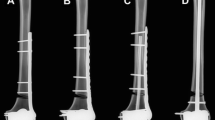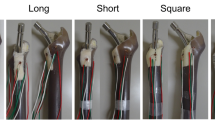Abstract
Purpose
Bone loss is often encountered in revision total knee arthroplasty. In particular, when the cortex of distal femur is breached, the surgical decision on the reconstructive options to be taken is challenging due to the variety of defects and the lack of data from clinical or experimental studies that can support it. The aim of the present work was to test the hypothesis that for an identical defect and bone condition, each reconstructive technique option has a dissimilar stress and stability behaviour, which may be related to differing longevity of the revision procedure.
Methods
Triaxial strain gauges and video extensometer were used to measure distal cortex strains and implant stability in eight reconstructive techniques replicated with synthetic femur under a load of 2030N. To assess the cancellous bone strains, finite element models were developed and validated.
Results
The measured strains showed that the distal cortex is not immune to the different reconstructive techniques, when applied to an identical defect; however, significant differences (P < 0.05) were found only between bone graft and metal augment on the 12-mm larger distal defect. The stem addition improves the stability of all reconstructive techniques; however, significant differences (P = 0.03) were found only on the bone-graft technique.
Conclusions
Cement-fill and metal-augment techniques, applied to the 4-mm smaller defect, are not associated with different structural behaviour, while for the 12-mm larger defect, the metal-augment and bone-graft techniques presented distinct biomechanical effects. These effects, by themselves, may not be sufficient to be associated with a different longevity of the revision procedure among techniques, when the stem is added to the bone-graft technique. These findings, based on independent scientific understanding and advanced prediction tools, can improve the surgical decision-making process, when the peripheral cortex of the distal femur is breached.




Similar content being viewed by others
References
Backstein D, Safir O, Gross A (2006) Management of bone loss: structural grafts in revision total knee arthroplasty. Clin Orthop Relat Res 446:104–112
Bozic KJ, Kurtz SM, Lau E, Ong K, Chiu V, Vail TP, Rubash HE, Berry DJ (2010) The epidemiology of revision total knee arthroplasty in the United States. Clin Orthop Relat Res 468:45–51
Chen AF, Choi LE, Colman MW, Goodman MA, Crossett LS, Tarkin IS, McGough RL (2013) Primary versus secondary distal femoral arthroplasty for treatment of total knee arthroplasty periprosthetic femur fractures. J Arthroplasty 28:1580–1584
Choi K, Goldstein SA (1992) A comparison of the fatigue behavior of human trabecular and cortical bone tissue. J Biomech 25:1371–1381
Cipolletti GB, Cook FW (1978) Fatigue of bone cement in physiological saline at one Hz. In: Transactions of the 4th annual society for biomaterials, 10th international biomaterials symposium. San Antonio, pp 134–135
Completo A, Fonseca F, Simões J, Ramos A, Relvas C (2012) A new press-fit stem concept to reduce the risk of end-of-stem pain at revision TKA: a pre-clinical study. Knee 19:537–542
Completo A, Duarte R, Fonseca F, Simões JA, Ramos A, Relvas C (2013) Biomechanical evaluation of different reconstructive techniques of proximal tibia in revision total knee arthroplasty: an in vitro and finite element analysis. Clin Biomech 28:291–298
Completo A, Simões J, Fonseca F (2009) Revision total knee arthroplasty: the influence of femoral stems in load sharing and stability. Knee 16:275–279
Completo A, Fonseca F, Relvas C, Ramos A, Simões J (2011) Improved Stability with intramedullary stem after anterior femoral notching in total knee arthroplasty. Knee Surg Sports Traumatol Arthrosc 20:487–494
Completo A, Rego A, Fonseca F, Ramos A, Relvas C, Simões JA (2010) Biomechanical evaluation of proximal tibia behaviour with the use of femoral stems in revision TKA: an in vitro and finite element analysis. Clin Biomech 25:159–165
Delloye C, Cornu O, Druez V, Barbier O (2007) Bone allografts: What they can offer and what they cannot. J Bone Joint Surg Br 89:574–580
Dennis DA (1998) Repairing minor bone defects: augmentation and autograft. Orthopedics 21:1036–1038
Engh GA, Herzwurm PJ, Parks NL (1997) Treatment of major defects of bone with bulk allografts and stemmed components during total knee arthroplasty. J Bone Joint Surg Am 79:1030–1039
Engh GA, Ammeen DJ (2007) Use of structural allograft in revision total knee arthroplasty in knees with severe tibial bone loss. J Bone Joint Surg Am 89:2640–2647
Franke KF, Nusem I, Gamboa G, Morgan DA (2013) Outcome of revision total knee arthroplasty with bone allograft in 30 cases. Acta Orthop Belg 79:427–434
Frost HM (2003) Bone’s Mechanostat: a 2003 update. Anat Rec A 275:1081–1101
Gardner MP, Chong AC, Pollock AG, Wooley PH (2010) Mechanical evaluation of large-size fourth-generation composite femur and tibia models. Ann Biomed Eng 38:613–620
Ghazavi M, Stockley I, Yee G, Davis A, Gross AE (1997) Reconstruction of massive bone defects with allograft in revision total knee arthroplasty. J Bone Joint Surg Am 79(17):25
Gross TS, Rubin CT (1995) Uniformity of resorptive bone loss induced by disuse. J Orthop Res 13:708–714
Hanna SA, Aston WJ, de Roeck NJ, Gough-Palmer A, Powles DP (2011) Cementless revision TKA with bone grafting of osseous defects restores bone stock with a low revision rate at 4 to 10 years. Clin Orthop Relat Res 469:3164–3171
Heiner A (2008) Structural properties of fourth-generation composite femurs and tibias. J Biomech 41:3282–3284
Hockman DE, Ammeen D, Engh GA (2005) Augments and allografts in revision total knee arthroplasty: usage and outcome using one modular revision prosthesis. J Arthroplasty 20:35–41
Huiskes R (1993) Mechanical failure in total hip arthroplasty with cement. Curr Orthop 7(239):247
Huten D (2013) Femorotibial bone loss during revision total knee arthroplasty. Orthop Traumatol Surg Res 99:22–33
Iosifidis M, Iliopoulos E, Neofytou D, Sakorafas N, Andreou D, Alvanos D, Kyriakidis A (2014) The Rotaglide mobile-bearing total knee arthroplasty: no difference between cemented and hybrid implantation. Knee Surg Sports Traumatol Arthrosc 22:1843–1848
Lim LA, Trousdale RT, Berry DJ, Hanssen AD (2011) Failure of the stem-condyle junction of a modular femoral stem in revision total knee arthroplasty: a report of five cases. J Arthroplasty 16:128–132
Loughead JM, Malhan K, Mitchell SY, Pinder IM, McCaskie AW, Deehan DJ, Lingard EA (2008) Outcome following knee arthroplasty beyond 15 years. Knee 15:85–90
Morrison JB (1970) The mechanics of the knee joint in relation to normal walking. J Biomech 3:51–61
Nazarian DG, Mehta S, Booth RE Jr (2002) A comparison of stemmed and unstemmed components in revision knee arthroplasty. Clin Orthop Relat Res 404:256–262
Panegrossi G, Ceretti M, Papalia M, Casella F, Favetti F, Falez F (2014) Bone loss management in total knee revision surgery. Int Orthop 38:419–427
Rand JA (1998) Modular augments in revision total knee arthroplasty. Orthop Clin North Am 29:347–353
Richards CJ, Garbuz DS, Pugh L, Masri BA (2011) Revision total knee arthroplasty: clinical outcome comparison with and without the use of femoral head structural allograft. J Arthroplasty 26:1299–1304
Saha S, Pal S (1984) Mechanical properties of bone cement: a review. J Biomed Mater Res 18:435–462
Sheng PY, Konttinen L, Lehto M, Ogino D, Jamsen E, Nevalainen J, Pajamaki J, Halonen P, Konttinen YT (2006) Revision total knee arthroplasty: 1990 through 2002. A review of the Finnish arthroplasty registry. J Bone Joint Surg Am 88:1425–1430
Taylor M, Tanner KE (1997) Fatigue failure of cancellous bone: a possible cause of implant migration and loosening. J-Bone-Joint-Surg Br 79:181–182
Whittaker JP, Dharmarajan R, Toms AD (2008) The management of bone loss in revision total knee replacement. J Bone Joint Surg Br 90:981–987
Zhang Y, Ahn P, Fitzpatrick D, Heiner A, Poggie R, Brown T (1999) Interfacial frictional behavior: cancellous bone, cortical bone, and a novel porous tantalum biomaterial. J Musculoskelet Res 3:245–251
Acknowledgments
The authors wish to thank: the Programa Operacional Fatores de Competitividade—COMPETE e por Fundos Nacionais através da FCT—Fundação para a ciência e a Tecnologia no âmbito dos projetos FCOMP-01-0124-FEDER-010248, FCOMP-01-0124-FEDER-015143 and FCOMP-01-0124-FEDER-015191.
Author information
Authors and Affiliations
Corresponding author
Rights and permissions
About this article
Cite this article
Completo, A., Fonseca, F., Ramos, A. et al. Comparative assessment of different reconstructive techniques of distal femur in revision total knee arthroplasty. Knee Surg Sports Traumatol Arthrosc 25, 2559–2566 (2017). https://doi.org/10.1007/s00167-015-3652-2
Received:
Accepted:
Published:
Issue Date:
DOI: https://doi.org/10.1007/s00167-015-3652-2




